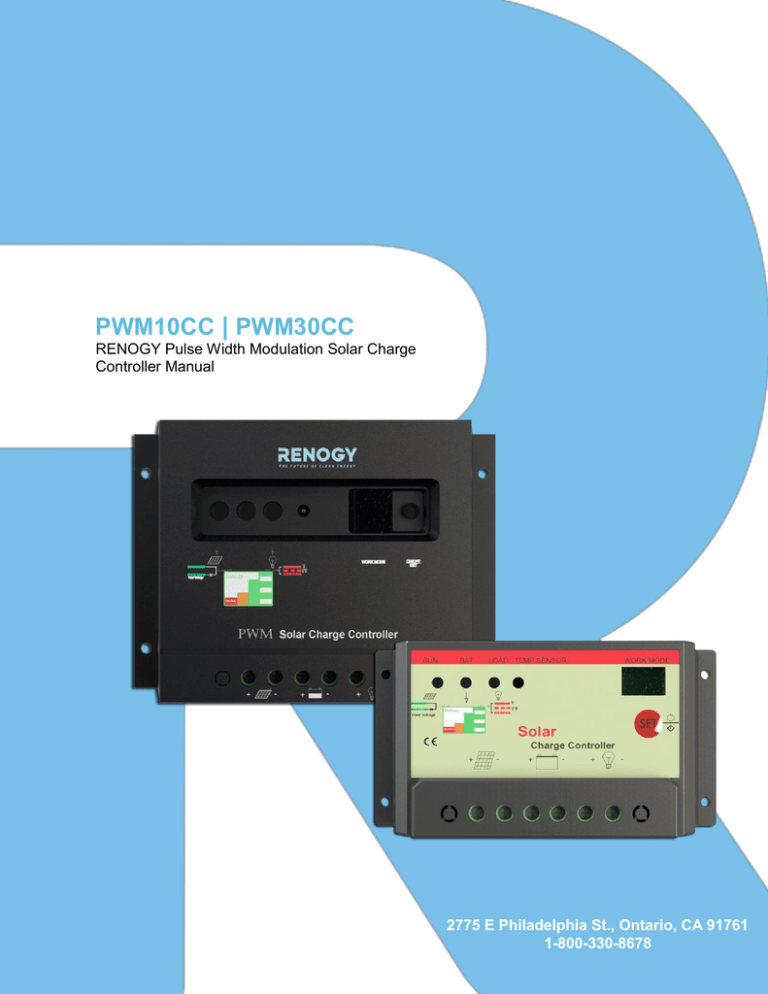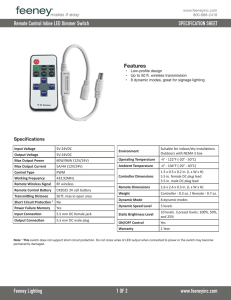
PWM10CC | PWM30CC
RENOGY Pulse Width Modulation Solar Charge
Controller Manual
2775
E Philadelphia
RENOGY
is a trademark ofSt.,
RNGOntario,
Group Inc. CA 91761
2015 RNG Group
Inc.
All
rights
reserved.
1-800-330-8678
1. Quick Start Instructions
This section provides a brief overview of how to begin using your solar charge controller. It is
recommended that each user review the entire manual to ensure the best possible performance
as well as maximize years of worry-free service. It is highly recommended that the connections
be made in the following steps provided:
1. Mount the charge controller onto a clean, vertical flat surface. It is very important to allow
enough space both above and below the charge controller to ensure maximum airflow.
2. Connect the Battery
: After proper mounting is established, connect the battery or
battery bank to the charge controller battery terminals. Be careful not to switch the
polarities of the battery and do not allow the bare wires to touch the metal casing of the
charge controller. As soon as the battery is connected to the charge controller, the
device will power automatically and will light green when the battery voltage is in the
right range.
3. Connect the Solar Panel(s)
: Connect the solar extension cables into the charge
controller PV terminals. The green LED indicator will light up if there is enough sunlight.
Make sure the solar module(s) voltage and current do not exceed the ratings of the
charge controller.
4. Connect the DC Loads (optional) : Connect 12VDC (12V systems) or 24VDC (24V
systems) loads to these terminals. The maximum rated current is 10 amps for the
PWM10CC and 30 amps for the PWM30CC. However, for safety, it’s recommended that
the loads do not exceed 80% of this rating. If the orange or red LED battery indicator
light turns on, the battery capacity is low and needs to be charged before using any of
the connected loads again. Do not connect devices such as power inverters, high
power DC motors/pumps or other DC electronics with heavy electrical load that
exceed the charge controller ratings.
5. After all connections are made as shown in Fig. 1, the charge controller will now be
providing charge to your battery or batteries. To test the system for proper connections,
press the SET button on the charge controller until you see number 6. (6 “Dot”) or 7. (7
“Dot”). See Table 1 for description of each work mode.
Solar Panel(s)
DC Load
Battery
Figure 1. Wiring diagram
1
2. Load Control Options
Press and hold the SET button for about 5 seconds until the display starts flashing. Press the
SET button once again to select the one of the desired control options shown in Table 1. When
done selecting the desired option, wait until the display stops flashing. The load LED will come
on, which will indicate that you have selected an option.
No. for 10A CC
No. for 30A CC
16
17
6.
7.
Description of Work Mode
Manually turn on/off load output with the SET button
Test mode/Dusk-to-Dawn light control:
(1) Light turns on after no sunlight detected
(2) Light turn off after sunlight detected
Table 1. Load control options
3. LED Indicators
Icon
Description
Green ON: Solar power is charging the battery
Green BLIKING: The system is over voltage
Green ON: Battery level is in the right range
Green SLOWLY FLASHING: Battery level is full
Orange ON: Battery level is low
Red ON: Load cut-off
Orange ON: The load output is on
Red SLOWLY FLASHING: Overload*
Red BLINKING: Load is short-circuit*
Table 2. LED indicators
*Note: The load amps is 1.25 times of the rated current for 60 seconds or the load amps is 1.5
times the rated current for 5 seconds. The output will shut off once there is an overload or short
circuit. Disconnect all of the equipment and then wait a few seconds before reconnecting
everything. Press the SET button and the controller will resume working after approximately 10
seconds, or in some instances, it may take a few moments longer.
2
4. Troubleshooting
1. Charging LED indicator turns off during the daytime
a. The green LED should be ON during the daytime.
b. Check to make sure the correct battery is being used.
c. Check all wiring connections to make sure they are in their designated locations
and make sure that there are no loose connections.
d. Measure the PV array open-circuit voltage and confirm it is within its normal
limits.
e. Measure the PV voltage and the battery voltage at the controller terminals. If the
voltage at the terminals is within proper specifications, the PV array is charging
the battery properly. If the PV voltage is within specifications to the open circuit
voltage rating of the panels, but the battery voltage is low, the charge controller
may not be charging the battery and it may be damaged.
2. Charging LED indicator is blinking
a. Check the operating conditions to confirm that the voltage is higher than the
specifications. Consider the temperature compensation of the charge controller’s
PWM set point. For example, at 0°C the charge controller will regulate at about
15 volts.
b. Check all wire connections in the system to ensure they are in the correct
location. Check for loose wires.
3. Red load LED indicator is blinking or flashing (load not operating properly)
a. Check the load to make sure it is on and make sure the fuses are not blown.
b. Check connections to the load, other controllers, and battery. Make sure the
voltage drops in the system wires are not exceeded.
c. If the LED indicator is blinking and there is no output, check the load for shortcircuit. In case of short-circuit, disconnect the load and press the SET button, and
wait for approximately 30 seconds for the charge controller to resume working
again.
d. If the LED indicator is still flashing and there is no output, check the load to make
sure the load is not over the rated power. Reduce the load and press the SET
button. Then wait for approximately 30 seconds for the charge controller to
resume working again.
3
5. Inspection and Maintenance
It is highly recommended that each user inspect the charge controller at least once per year to
ensure longevity and optimal performance. Please follow this procedure:
1. Confirm that the correct battery type has been used.
2. Confirm that the current levels of the solar array and load do not exceed the controller
ratings.
3. Inspect for loose, broken, or burnt wire connections and replace them if needed. Make
sure all terminals are tightened.
4. Press the SET button until number 16 is displayed to verify the lights are working
properly.
5. Inspect for dirt, insects, and corrosion on the charge controller.
6. Check to make sure there is still enough space around the charge controller for
maximum airflow.
7. Check to make sure the charge controller functions and LED indicators are working
properly.
8. Make sure the PV array is clean and remove any debris.
9. Make sure all of the railings and PV bolts are tightened.
6. Charge Controller Specifications
Controller Parameters
Description
Nominal System Voltage
Rated Charge Current
Rated Load Current
Max. Solar Input Voltage
Max. PV Input Power
Self-consumption
Operating Temperature
Temp. Compensation
Terminals
25% Current Overload
10A Parameters
12V/24V Auto recognition
10A
10A
42V
120W (12V), 240W (24V)
< 6mA
-35°C to + 55°C
-30mV/°C (12V), -60mV/°C (24V)
10 AWG
1 Minute
Table 3. Electrical Parameters
30A Parameters
12V/24V Auto recognition
30A
30A
42V
360W (12V), 720W (24V)
< 6mA
-35°C to + 55°C
-30mV/°C (12V), -60mV/°C (24V)
10 AWG
1 Minute
Note: For safety, do not exceed 80% of charge controller current rating. This rating should be based on
total short-circuit current of the solar panels.
Battery Parameters
Description
Load Disconnect
Load Reconnect
Equalization Voltage (30 minutes)
Boost Voltage (30 minutes)
Float Voltage
Battery type
Parameter
11.1V (12V), 22.2V (24V)
12.6V (12V), 25.2V (24V)
14.6V (12V), 29.2V (24V)
14.4V (12V), 28.8V (24V)
13.6V (12V), 27.2V (24V)
Sealed Lead Acid and Flooded
Table 4. Battery Parameters
Updated: July 20, 2015
4



